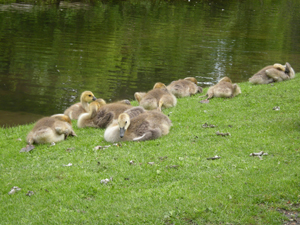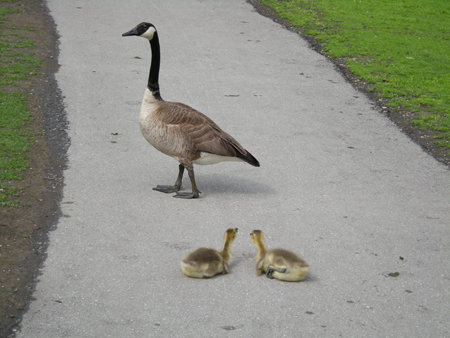
Canada Goose biology and life stages
Spring Arrival: Canada geese arrive in the spring to Manitoba from more southern wintering grounds. Hours of daylight and weather affect the timing of migration. Geese have strong homing abilities and are able to return to the same site each year. In fact, female geese will often nest near the location where they hatched.
Nesting and Brooding: In urban areas, geese will nest at retention basins, in parks, near sidewalks, entrances of buildings, paths and roadways and even on raised structures, such as rooftops. They prefer to nest within 50 metres of water and geese are loyal to nest sites, with the female often setting up a nest along with her partner in the area where she hatched.
Geese will typically lay between 2 and 12 eggs, with an average of 5 eggs. Egg laying takes about 1 to 2 weeks to complete depending on the final number of eggs. Eggs are incubated for about 28 days and once the goslings hatch, they, along with the adults, will walk to their brood-rearing location near water.

Brood rearing: Families consisting of the adult pair and their goslings stay together as a unit. Groups of families called brood gangs will also form and consist of between 2 to 20 adults along with 20 to 100 goslings. Access to water may not be a requirement of geese during nesting, but once goslings are present the group will search out easy access to water. Retention basins are ideal brood rearing habitat.
Moulting and Feeding: Feeding groups typically consist of flightless goslings, breeding and non-breeding adults. Adults are also flightless for part of the summer months. Adult geese moult, completely replacing their flight feathers each year. It takes about 4 to 6 weeks to complete and it more or less coincides with the time that the goslings are flightless.

Geese congregate during the moult near areas that are close to and have easy access to water, have an abundance of food and have wide open views of potential predators. Gulls, domestic dogs, ravens, crows, skunks and foxes are predators of both eggs and goslings in urban environments. The security of water provides geese and their goslings an escape route when danger arises. They need to walk into water because they can't fly. Geese with young will defend them vigorously and are unlikely to abandon them when threatened.
Migration: Resident Canada geese will begin to get ready to migrate as the days get shorter. Geese that nest in the City of Winnipeg don't go really far as we think, in fact, many of "our" geese end up in Minnesota. The migrators that show up in the city in the fall come from further north and end up even migrating further south than our resident geese.
